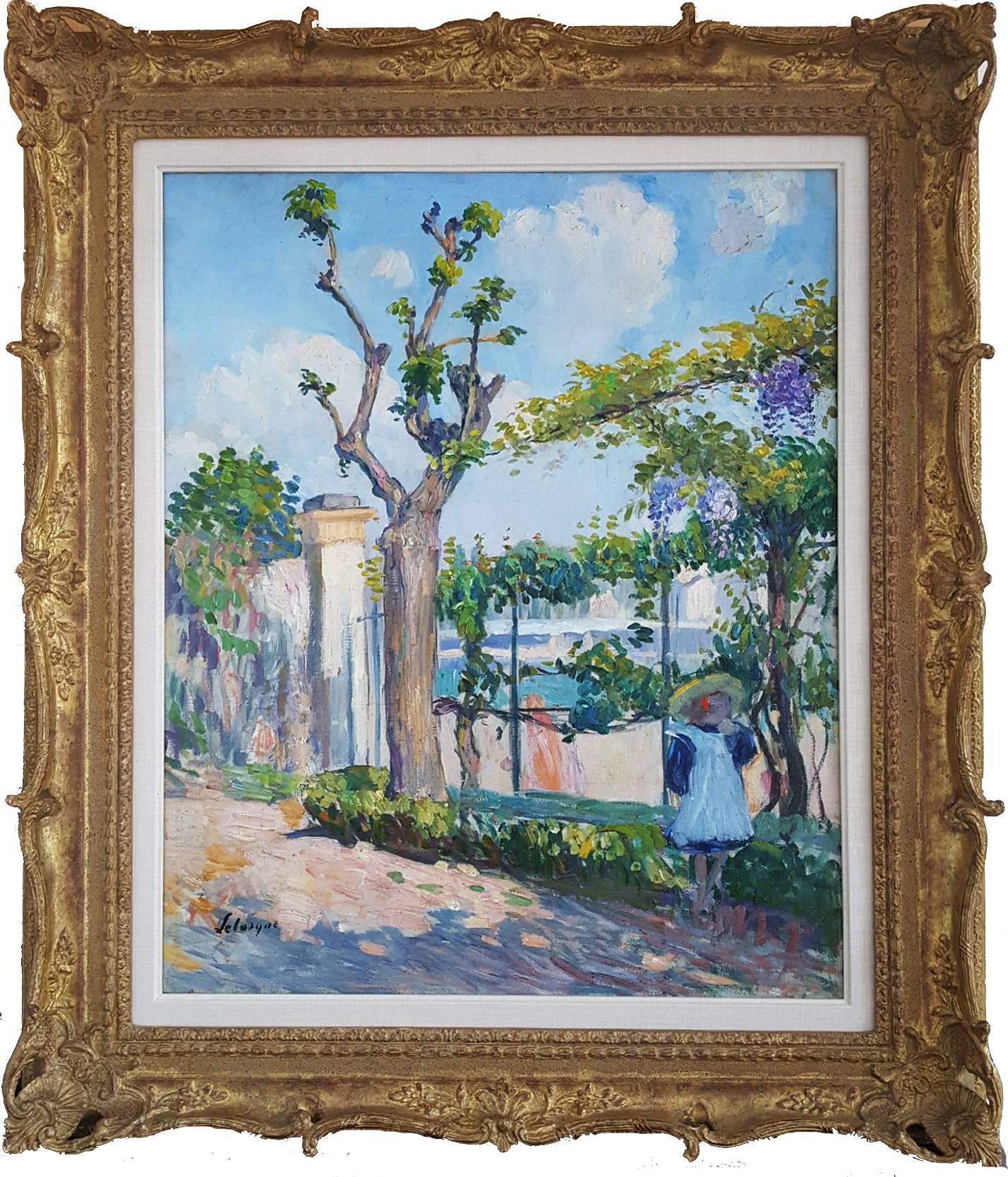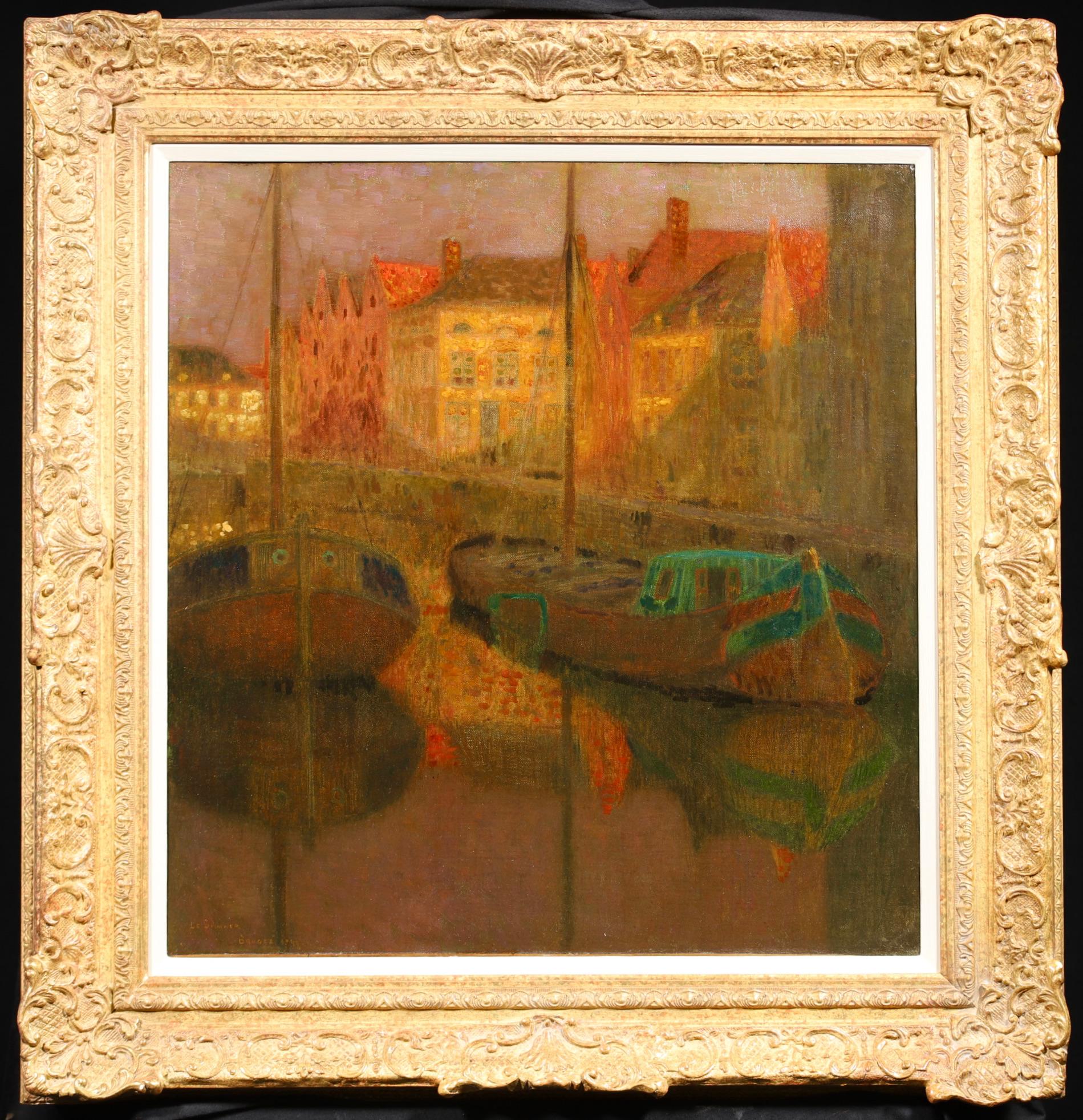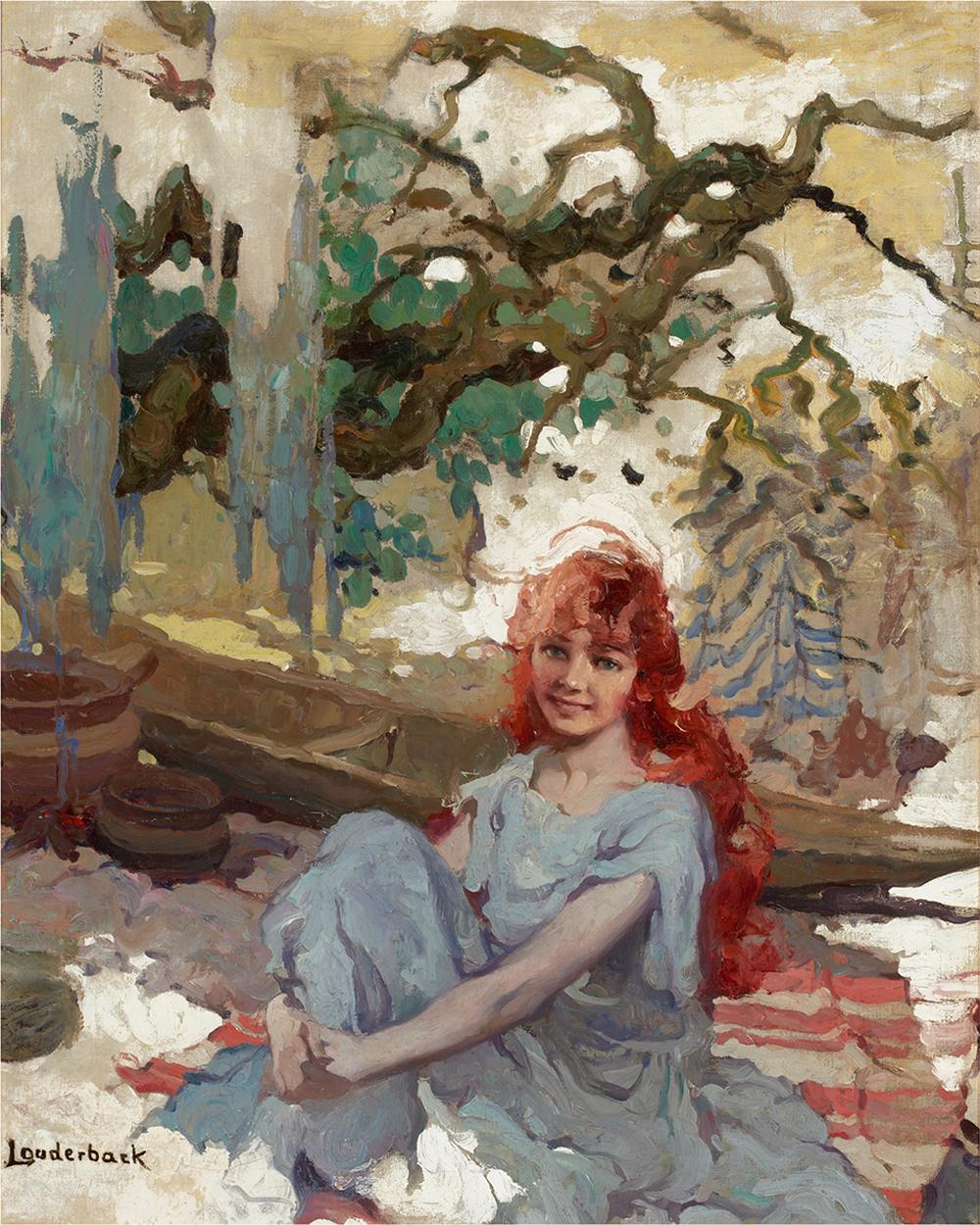Items Similar to Woman in Kimono
Want more images or videos?
Request additional images or videos from the seller
1 of 8
Everett Lloyd BryantWoman in Kimono1920's
1920's
About the Item
Everett Lloyd Bryant
American, 1864-1945
Woman in Kimono
Oil on canvas
Signed lower right
30 by 25 in. W/frame 35 by 30 in.
Everett studied with Blanc and Couture in Paris; Herkomer, in London;
Pennsylvania Academy of Fine Arts, with Anshutz, Chase, and Breckenridge, 1901-04.
He was a member of the Baltimore Watercolor Society; Philadelphia Watercolor Club;
California Watercolor Society.
He exhibited at the Salons of the Societe National des Beaux Arts, Paris, 1895;
Pennsylvania Academy of Fine Arts, 1904-24; Art institute of Chicago; Pan-Pacific Exposition.,
San Francisco, 1915 (Silver medal); Corcoran Gallery, 1916-23; Arlington Gallery, NYC, 1918;
Los angeles Art association, 1934; Golden Gate Exposition, San Francisco, 1939;
Brooklyn Museum of Art, 1946 (Memorial).
Museums: Pennsylvania Academy of Fine Arts; Baltimore Museum of Art;
St. Paul Art Institute; Los Angles County Museum of Art.
Art B77
- Creator:
- Creation Year:1920's
- Dimensions:Height: 35 in (88.9 cm)Width: 30 in (76.2 cm)Depth: 2 in (5.08 cm)
- Medium:
- Movement & Style:
- Period:
- Condition:
- Gallery Location:Sheffield, MA
- Reference Number:
About the Seller
3.7
Vetted Seller
These experienced sellers undergo a comprehensive evaluation by our team of in-house experts.
1stDibs seller since 2017
46 sales on 1stDibs
- ShippingRetrieving quote...Ships From: Sheffield, MA
- Return PolicyThis item cannot be returned.
More From This SellerView All
- Le Piège à OiseauxBy Georges d'EspagnatLocated in Sheffield, MAGeorges D'espagnat French, 1870 - 1950 Le Piège à Oiseaux Signed gdE (lower right) Oil on canvas 66 3/4 by 48 1/2 in. W/frame 70 ¾ by 52 ½ in. Born at Melun on 14th August 1870, G...Category
1910s Post-Impressionist Figurative Paintings
MaterialsOil
- Les VendangesBy Georges d'EspagnatLocated in Sheffield, MAGeorges d'Espagnat French, 1870 - 1950 Les Vendanges Signed gdE (lower left) Oil on canvas 67 by 43 in. W/frame 71 by 47 in. Born at Melun on 14th August 1870, Georges d’Espagnat...Category
1910s Post-Impressionist Figurative Paintings
MaterialsOil
- BathersBy John Edward CostiganLocated in Sheffield, MAJohn Edward Costigan, N.A. American, 1888-1972 Bathers Oil on canvas Signed ‘J.E. Costigan N.A.’ lower left 20 by 24 in. W/frame 26 by 30 in. John Costigan was born of Irish-American parents in Providence, Rhode Island, February 29, 1888. He was a cousin of the noted American showman, George M. Cohan, whose parents brought the young Costigan to New York City and was instrumental in starting him on a career in the visual arts. They were less successful in encouraging him to pursue formal studies at the Art Students League (where, however, he later taught) than in exposing him to the commercial art world through the job they had gotten him with the New York lithographing firm that made their theatrical posters. At the H. C. Miner Lithographing Company, Costigan worked his way up from his entry job as a pressroom helper, through various apprenticeships, to the position of sketch artist. In the latter capacity he was an uncredited designer of posters for the Ziegfeld Follies and for numerous silent films. Meanwhile, he had supplemented his very meager formal studies in the fine arts with a self-teaching discipline that led to his first professional recognition in 1920 with the receipt of prizes for an oil painting and watercolor in separate New York exhibitions. A year earlier, Costigan had wed professional model Ida Blessin, with whom he established residence and began raising a family in the sleepy little rural New York hamlet of Orangeburg, the setting for the many idyllic farm landscapes and wood interiors with which he was to become identified in a career that would span half a century. John Costigan’s first national recognition came in 1922 with his winning of the coveted Peterson Purchase prize of the Art Institute of Chicago for an oil on canvas, “Sheep at the Brook.” It marked the start of an unbroken winning streak that would gain him at least one important prize per year for the remainder of the decade. The nation’s art journalists and critics began to take notice, making him the recurring subject of newspaper features and magazine articles. The eminent author and critic Edgar Holger Cahill was just a fledgling reporter when he wrote his first feature, “John Costigan Carries the Flame,” for Shadowland Magazine in 1922. Costigan had his first one-man show of paintings at the Rehn Gallery on New York’s 5th Avenue in November, 1924, to be followed less than three years later by another at the Art Institute of Chicago. In addition, Costigan’s work has been—and continues to be included, side-by-side with that of some of America’s most high-profile artists, in museum and gallery exhibitions throughout the country. His renown had peaked in the early 1930s, by which time his work had been honored with nearly every major award then being bestowed in the fine arts and had been acquired for the permanent collections of several prestigious American museums, including New York’s Metropolitan (which only recently, in 1997, deaccessioned his “Wood Interior,” acquired in 1934). Although Costigan’s celebrity had ebbed by the late 1930s, the Smithsonian Institution saw fit in 1937 to host an exhibition exclusively of his etchings. And, in 1941, the Corcoran Gallery (also Washington, D.C.) similarly honored him for his watercolors. (Another Washington institution, the Library of Congress, today includes 22 Costigan etchings and lithographs in its permanent print collection.) During World War II, Costigan returned briefly to illustrating, mainly for Bluebook, a men’s pulp adventure magazine. A gradual revival of interest in his more serious work began at the end of the war, culminating in 1968 with the mounting of a 50-year Costigan retrospective at the Paine Art Center and Arboretum in Oshkosh, Wisconsin. Oils, watercolors and prints were borrowed from museums and private collections throughout the country, and the exhibition was subsequently toured nationally by the Smithsonian Institution. John Costigan died of pneumonia in Nyack, NY, August 5, 1972, just months after receiving his final prestigious award —the Benjamin West Clinedinst Medal of the Artist’s Fellowship, Inc., presented in general recognition of his “...achievement of exceptional artistic merit...” in the various media he had mastered in the course of his career. This painting depicts one of the artist's favorite themes --the farm family bathing...Category
1950s Post-Impressionist Figurative Paintings
MaterialsOil
- Woman and ChildBy John Edward CostiganLocated in Sheffield, MAJohn Edward Costigan, N.A. American, 1888-1972 Woman and Child Oil on canvas Signed ‘J.E. Costigan N.A.’ lower left 24 by 30 in. W/frame 32 by 38 in. John Costigan was born of Irish-American parents in Providence, Rhode Island, February 29, 1888. He was a cousin of the noted American showman, George M. Cohan, whose parents brought the young Costigan to New York City and was instrumental in starting him on a career in the visual arts. They were less successful in encouraging him to pursue formal studies at the Art Students League (where, however, he later taught) than in exposing him to the commercial art world through the job they had gotten him with the New York lithographing firm that made their theatrical posters. At the H. C. Miner Lithographing Company, Costigan worked his way up from his entry job as a pressroom helper, through various apprenticeships, to the position of sketch artist. In the latter capacity he was an uncredited designer of posters for the Ziegfeld Follies and for numerous silent films. Meanwhile, he had supplemented his very meager formal studies in the fine arts with a self-teaching discipline that led to his first professional recognition in 1920 with the receipt of prizes for an oil painting and watercolor in separate New York exhibitions. A year earlier, Costigan had wed professional model Ida Blessin, with whom he established residence and began raising a family in the sleepy little rural New York hamlet of Orangeburg, the setting for the many idyllic farm landscapes and wood interiors with which he was to become identified in a career that would span half a century. John Costigan’s first national recognition came in 1922 with his winning of the coveted Peterson Purchase prize of the Art Institute of Chicago for an oil on canvas, “Sheep at the Brook.” It marked the start of an unbroken winning streak that would gain him at least one important prize per year for the remainder of the decade. The nation’s art journalists and critics began to take notice, making him the recurring subject of newspaper features and magazine articles. The eminent author and critic Edgar Holger Cahill was just a fledgling reporter when he wrote his first feature, “John Costigan Carries the Flame,” for Shadowland Magazine in 1922. Costigan had his first one-man show of paintings at the Rehn Gallery on New York’s 5th Avenue in November, 1924, to be followed less than three years later by another at the Art Institute of Chicago. In addition, Costigan’s work has been—and continues to be included, side-by-side with that of some of America’s most high-profile artists, in museum and gallery exhibitions throughout the country. His renown had peaked in the early 1930s, by which time his work had been honored with nearly every major award then being bestowed in the fine arts and had been acquired for the permanent collections of several prestigious American museums, including New York’s Metropolitan (which only recently, in 1997, deaccessioned his “Wood Interior,” acquired in 1934). Although Costigan’s celebrity had ebbed by the late 1930s, the Smithsonian Institution saw fit in 1937 to host an exhibition exclusively of his etchings. And, in 1941, the Corcoran Gallery (also Washington, D.C.) similarly honored him for his watercolors. (Another Washington institution, the Library of Congress, today includes 22 Costigan etchings and lithographs in its permanent print collection.) During World War II, Costigan returned briefly to illustrating, mainly for Bluebook, a men’s pulp adventure magazine. A gradual revival of interest in his more serious work began at the end of the war, culminating in 1968 with the mounting of a 50-year Costigan retrospective at the Paine Art Center and Arboretum in Oshkosh, Wisconsin. Oils, watercolors and prints were borrowed from museums and private collections throughout the country, and the exhibition was subsequently toured nationally by the Smithsonian Institution. John Costigan died of pneumonia in Nyack, NY, August 5, 1972, just months after receiving his final prestigious award —the Benjamin West Clinedinst Medal of the Artist’s Fellowship, Inc., presented in general recognition of his “...achievement of exceptional artistic merit...” in the various media he had mastered in the course of his career. This painting depicts one of the artist's favorite themes --the farm family bathing...Category
1940s Post-Impressionist Landscape Paintings
MaterialsOil
- Djeuner ChamptreBy Marcel DyfLocated in Sheffield, MAMarcel Dyf French, 1899-1985 Djeuner Champtre Oil on canvas 23 ½ by 28 ¾ in. W/frame 31 ½ by 36 ¾ in. Signed lower left Marcel Dyf (Marcel Dreyfus) was born in Paris on October 7,...Category
1950s Post-Impressionist Figurative Paintings
MaterialsOil
- Father & ChildBy Renato GuttusoLocated in Sheffield, MARenato Guttuso Italian 1911-1987 Father & Child Oil on canvas 30 ½ by 19 in. W/frame 31 ½ in. by 20 in. Signed verso "Guttuso" Signed lower center "Guttuso" Dated 1966 Titled vers...Category
1960s Modern Figurative Paintings
MaterialsOil
You May Also Like
- Bords du Loing by Alfred Sisley - Oil, landscape paintingBy Alfred SisleyLocated in London, GB*THIS PRICE INCLUDES 5% IMPORT DUTY APPLICABLE IF THE WORK REMAINS IN THE UK ONLY. Bords du Loing by Alfred Sisley (1839-1899) Oil on canvas 46.1 x 55.7 cm (18¹/₈ x 21⁷/₈ inches) S...Category
1890s Post-Impressionist Landscape Paintings
MaterialsCanvas, Oil
- Le Jardin de Lagny - Garden with young girl Post-impressionistBy Henri LebasqueLocated in Miami, FLLe Jardin de Lagny Provenance: Arthur Tooth, London Radon Gallery, NY This beautiful evocation of a lyrical French landscape is a fine example of of Po...Category
Early 1900s Post-Impressionist Landscape Paintings
MaterialsOil, Canvas
- Barques de Peche - Post Impressionist Landscape Oil by Henri Le SidanerBy Henri Le SidanerLocated in Marlow, BuckinghamshireSigned post impressionist landscape oil on canvas by French painter Henri Le Sidaner. This stunning piece depicts two fishing boats moored in a fishing village at sunset. The last l...Category
1890s Post-Impressionist Landscape Paintings
MaterialsOil, Canvas
- Girl with canoe painted in Arts and Crafts styleBy Walt LouderbackLocated in Miami, FLSigned lower left. Most likely for Saturday Evening Post or Colliers. Louderback is a painter/illustrator of the Golden Age of Illustration...Category
1920s Post-Impressionist Figurative Paintings
MaterialsCanvas, Oil
- "Boulevard of Paris", 20th Century oil on canvas by Spanish artist E. Grau SalaBy Emilio Grau SalaLocated in Madrid, ESEMILIO GRAU SALA Spanish, 1911 - 1975 BOULEVARD OF PARIS signed Grau Sala (lower right) oil on canvas 25-1/2 X 32 inches (65 X 81 cm.) framed: 36-1/4 X 42-1/2 inches (92 X 108 cm.) PROVENANCE Sale: Sotheby´s Olympia London, 20 October 2006 Emilio Grau Sala came from a family of artists. He was born in Barcelona in 1911 and his father, a good cartoonist, had been one of the promoters of the "Salon des Humanistes" and made his exhibitions normally in the Parés Hall. His first works were exhibited at the Salon des Independents, in the years 1930-33. Grau Sala was essentially a Mediterranean painter, son of post-impressionism and enriched with French painting of the last fifty years. In this work Grau Sala has a loose, subtle brushstroke, in which the color shapes the entire work. The bright and transparent whites that give life to young schoolgirls contrast with the brushstrokes of blacks from the nun who accompanies them. The explosion of greens is refreshing, it surrounds us and transports us to an idyllic place, even if it is a citizen boulevard, which becomes friendly and beautiful. His works can be found in the Museums of the Villa de Paris, L'Ile de France Museum, at the Château de Sceaux, Honfleur Museum, La Rochelle Museum, Barcelona Museum, Tossa de Mar...Category
1950s Post-Impressionist Landscape Paintings
MaterialsOil, Canvas
- An Evening Walk - Post Impressionist Oil, Figures at Night by Henri Le SidanerBy Henri Le SidanerLocated in Marlow, BuckinghamshireSigned post impressionist figurative oil on panel circa 1910 by sought after French painter Henri Le Sidaner. This absolutely stunning piece depicts elegant people taking an evening ...Category
1910s Post-Impressionist Figurative Paintings
MaterialsPanel, Oil




